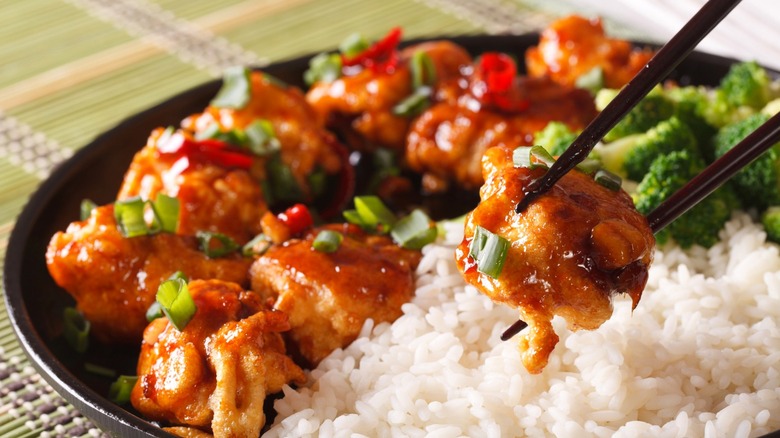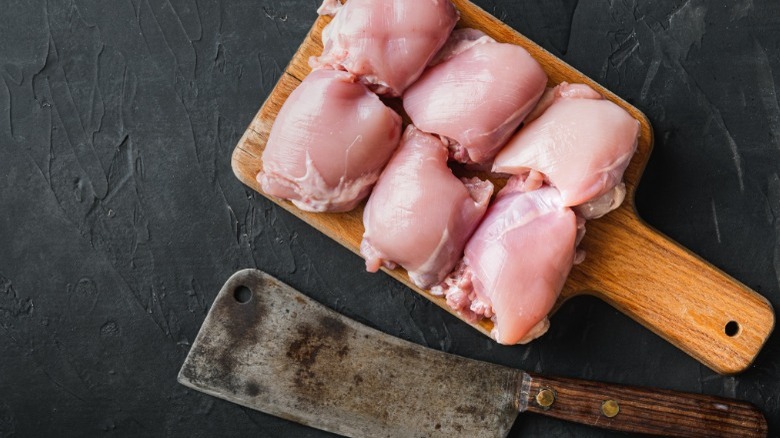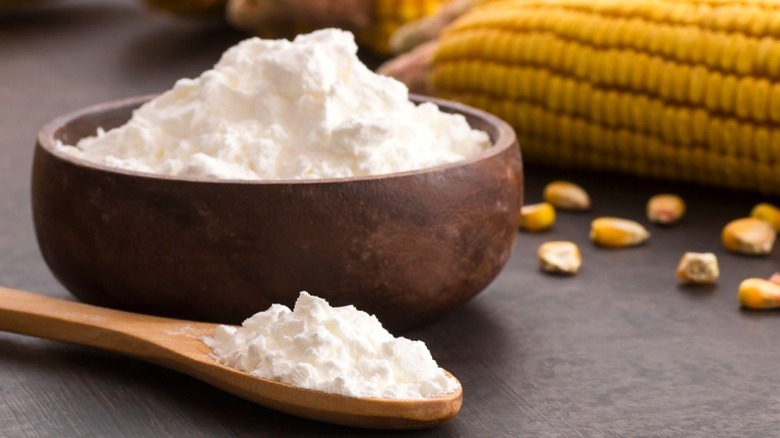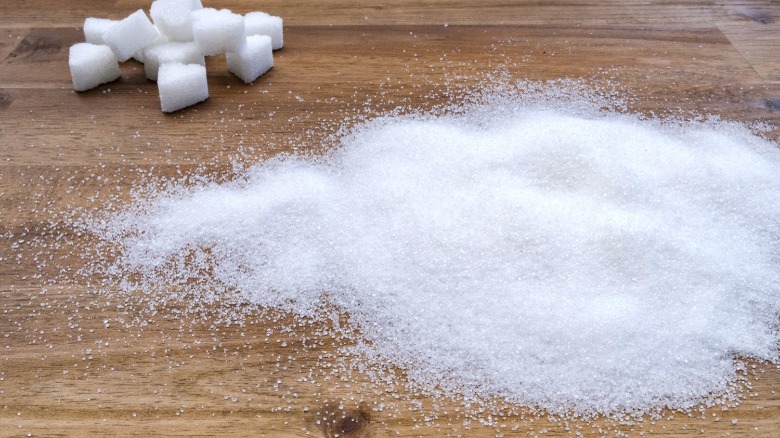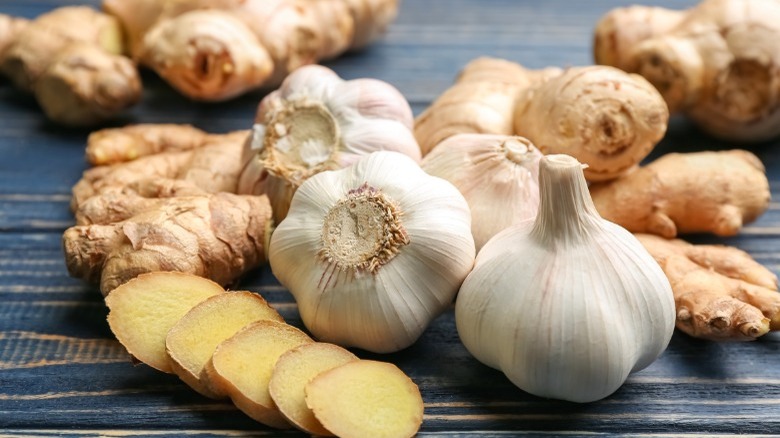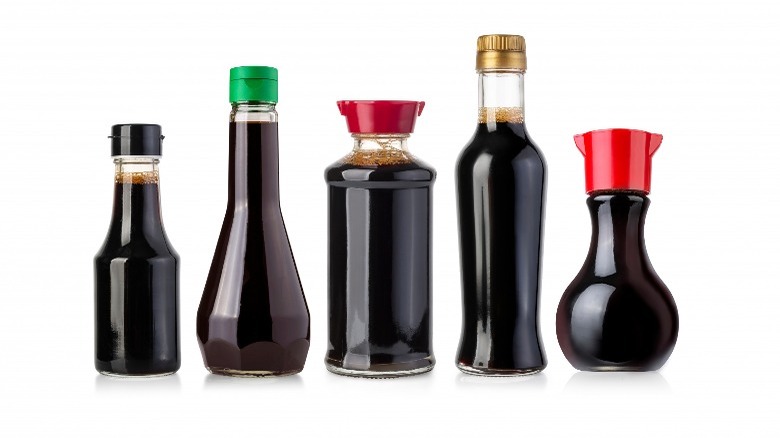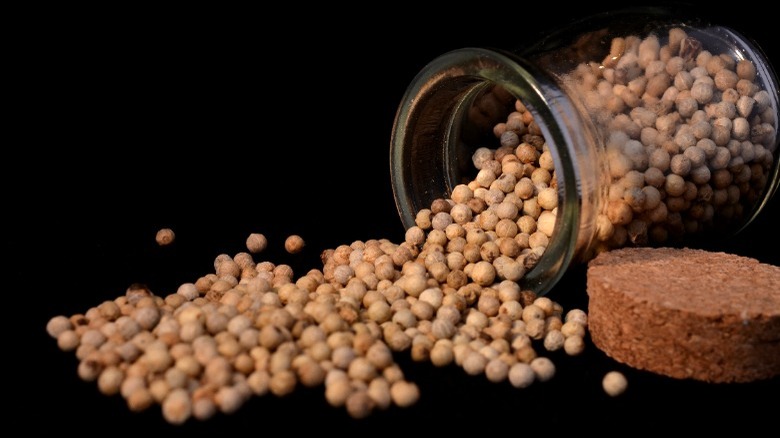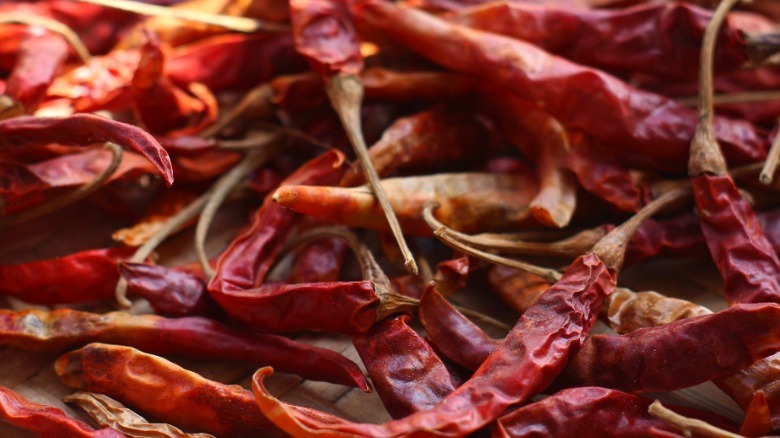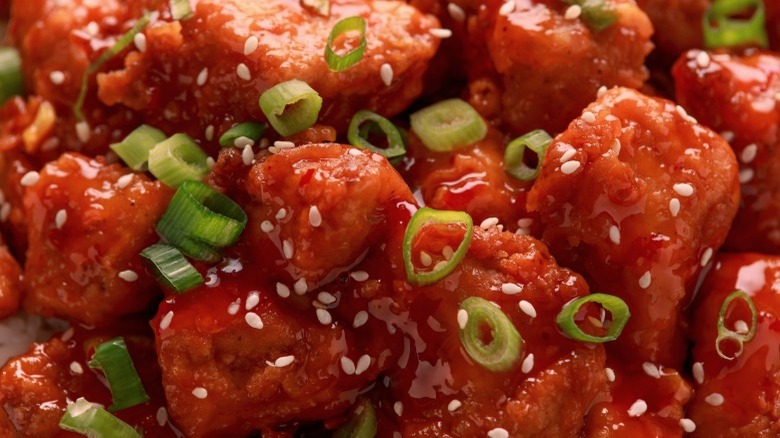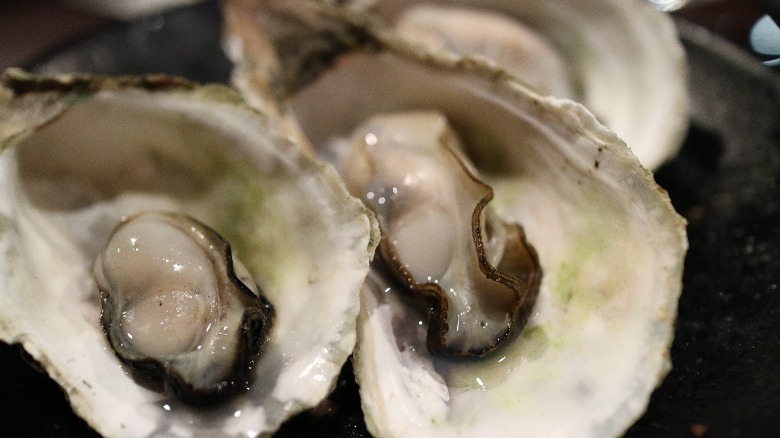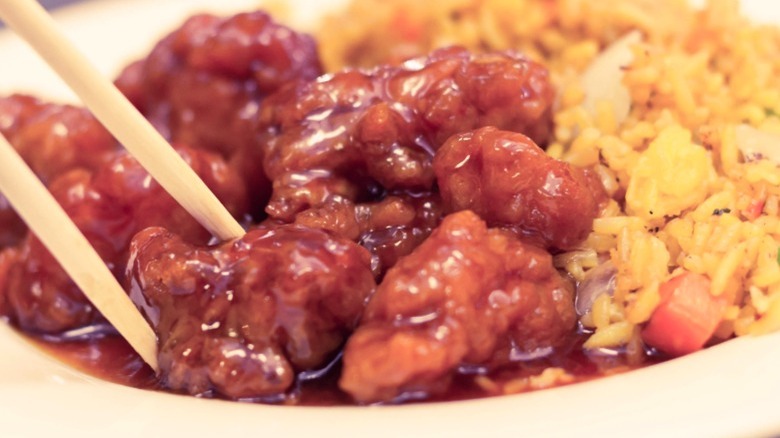Here's What You're Really Eating When You Eat General Tso's Chicken
Chinese restaurants are among the most popular casual dining and takeout picks in the United States. According to the United Chinese American Restaurant Association, there are over 45,000 Chinese restaurants across the country — which is more than the combined number of U.S. McDonald's, Burger King, KFC, and Wendy's locations (via BBC). And among those Chinese establishments, there's one dish that reigns supreme as the most popular: General Tso's chicken (via NBC).
Ironically, as omnipresent as the dish is in the U.S., it's basically just as elusive in China. General Tso's chicken originates not from China but from Taiwan, where chef Peng Chang-kuei, after fleeing China's Communist Revolution, concocted a Hunan-inspired meal while catering to government officials (per "Authenticity in the Kitchen"). In its migration to the U.S., the dish strayed from its roots: The sauce became sweeter and the chicken became crunchier.
Real Chinese food? Maybe not. Delicious nonetheless? Absolutely. "It's one of the dishes that American-Chinese food was built upon," explains chef Doron Wong (via Grub Street). "Sweet, sour, and spicy, with a little bit of umami — those flavors are crave-worthy." But what makes it that way? Read on to find out what exactly goes into making one of America's most beloved takeout traditions. You might even be inspired to whip up a batch of General Tso's chicken yourself.
General Tso's chicken typically uses dark meat
Unless specified otherwise on the menu or packaging, General Tso's chicken will likely be made with dark meat (from the thigh or drumstick) as opposed to white meat (from the breast). Mashed's homemade General Tso's chicken recipe calls for chicken thighs diced into 1-inch chunks, noting that this cut is "slightly meatier and more flavorful" than chicken breasts. Dark meat does in fact have a more succulent texture and taste, and biology is to thank.
The difference in the two has to do with the fiber makeup of the muscles: The breast and wings contain approximately 10% red fibers, while the legs and thighs, because they're used more frequently, are closer to 50% red fibers, and therefore juicer (via MasterClass).
Yes, we've been taught that white meat is generally healthier than dark meat. But one, don't knock the nutritional benefits of dark meat; and two, we're about to fry the chicken and toss it in a sugary sauce. In other words, we're eating it because it's tasty, not because it's good for us.
The chicken is coated in cornstarch
A common ingredient in Chinese cooking is cornstarch, a chalky white maize-based powder (not be confused with the coarser cornmeal). A technique called velveting involves marinating ingredients in a cornstarch and egg white mixture, then dipping them quickly in hot oil or water. This helps to tenderize proteins, to give them an evenly golden crust, and to ensure a silky texture (via Bon Appétit).
But you don't even need to go through the full velveting process to yield crispy chicken. Dredging the pieces in a batter made with cornstarch and flour (or even just cornstarch) before frying will create a lighter, crunchier crust than one made with just flour. This is because cornstarch is more effective in absorbing moisture and preventing gluten development, according to Kitchn.
The magic ingredient is also often used as a thickening agent in another element of General Tso's chicken: that sticky, gloopy, and oh-so-satisfying sauce. When using cornstarch this way, it's important to first make a slurry by stirring it into water, then pouring the pasty mixture into the sauce. Once the slurry is added, the sauce needs to simmer for a bit in order to activate the cornstarch, and it requires constant stirring, lest you end up with a lumpy sauce.
A few different types of oil are at play
Most recipes and ingredient lists for General Tso's chicken contain two (or more) different oils. They serve different purposes, and cannot be substituted for one another. First, there's the cooking oil. This is the spot for a neutral pick — one that won't add much of its own flavor. It's also important that whatever cooking oil you choose has a high smoke point. Certain oils, once they reach the temperatures required for frying, leave unpleasant tastes and release harmful chemicals. With those criteria in mind, this isn't the place for a nice olive oil (or any olive oil, for that matter). Instead, use vegetable or canola oil, or go the route of Panda Express, which uses soybean oil in their General Tso's chicken.
Later in the process, sesame oil usually joins the party. Due to its strong flavor and low smoke point, this is more of a finishing oil than one used to actually cook ingredients. Sesame oil is derived from — you guessed it — sesame seeds, and imparts a subtle, nutty note to a variety of dishes.
There's plenty of sugar
Unlike its initial incarnation, the General Tso's chicken we would usually order from restaurants today is exceptionally sweet (as well as tangy and spicy) in order to cater to the American palate. The shift in flavor profile was initially made, Smithsonian Magazine explains, when chef Tsung Ting Wang popularized the dish in New York City. Clearly, Wang was onto something. A 2015 study from Euromonitor, as cited in The Washington Post, shows that the average person in the United States consumes more than 126 grams of sugar daily — more than any of the 53 additional countries included in the report.
Given this, it's no surprise that sugar is one of the main ingredients in General Tso's sauce. The National Nutrient Database (via LiveStrong) estimates an average order of the dish to contain 62 grams of sugar (12 grams more than the FDA's recommended Daily Value of added sugars). If you're trying to cut back on sugar but craving General Tso's chicken, it may be best to make your own at home (Mashed's General Tso's recipe calls for 3 tablespoons across six servings) or seek out a version closer to Peng Chang-kuei's original dish.
Garlic, scallions, and ginger add aromatics
Cuisines around the world utilize signature blends of aromatics that make their dishes unique. For the French, it's mirepoix (onions, carrots, and celery); in Spain, there's sofrito (garlic, onion, and tomato); Cajun cuisine has the Holy Trinity (onion, celery, and green bell pepper). China is no exception. In discussing her renowned congee recipe, "Top Chef" Season 12 winner Mei Lin refers to ginger, garlic, and scallion as the "Holy Chinese Trinity." Indeed, the combination is a frequent starting point for sauces (General Tso's included), fillings, stir fries, and more.
To get the most out of this trio, Serious Eats suggest sweating them out with a bit of oil over low heat until soft, then adding the liquid ingredients. Garlic can burn easily when cooked with high heat, which can make a dish bitter.
Additional vegetables making cameos in General Tso's chicken vary based on the restaurant or recipe. Panda Express, for instance, includes red and yellow bell peppers, onions, and string beans; Pei Wei Asian Kitchen tosses shredded carrots and bean sprouts into their version.
Soy sauce helps create the base to General Tso's sauce
Like the aromatic trio of garlic, ginger, and scallion, soy sauce is a nearly ubiquitous component of dishes across many parts of Asia, making it a natural fit for the roster of ingredients that make up General Tso's chicken.
Though prevalent in myriad countries, soy sauce originated in China not as the brew we know today but as a fermented paste used in preservation (via "Salt: A World History"). In the thousands of years since, wheat was introduced to the mix, it took on a thinner consistency, and became commercially produced around the world.
Now that we have more technologically advanced means of storing food (think refrigerators and canning), soy sauce is used less as a preserver and more as an umami-packed condiment. "For Chinese cooking, soy sauce is a key ingredient for the flavor, not just for the saltiness but also for all the funky flavors that come with the different aging and fermenting methods," explains "Chinese Soul Food" author Hsiao-Ching Chou to Epicurious.
White pepper is a seasoning staple
While black pepper may be found more often in Western kitchens, the white variety is a common seasoning in Chinese cooking. They're not different colored berries (yes, peppercorns are berries), but rather the same product processed in different ways.
The food blog The Woks of Life explains that white pepper is cultivated when the peppercorn is ripe, and the outer shell is stripped (as opposed to black pepper, in which the berry is unripe and the skin remains intact). It goes on to describe the taste as "earthy" and "more uniformly hot/spicy" compared to the "floral, pungent aroma" of black pepper. That's why white pepper is the spice of choice in dishes like hot and sour soup.
And good news: White pepper is said to have medicinal properties. Shanghai Daily writes that traditional Chinese practices associate the spice with inflammation reduction, pain management, and stomach soothing. That may not offset all the oil and sugar in General Tso's chicken, but hey, it's a start.
Whole dried chiles kick up the heat
White pepper will offer a lingering note of spice throughout a dish, but a good General Tso's chicken also has a heat that punches you in the taste buds when you first dig in. That's where chiles come into play. Certain versions of the meal include whole dried chiles that have been cooked with the other aromatic ingredients in the sauce, and are occasionally left in the final presentation for anyone who'd dare to take a bite.
While General Tso's chicken is not a traditional Chinese dish, it is at least a nod to Hunan cuisine in which dried Tien Tsin chiles are commonly used. Pepper Scale clocks Tien Tsin chiles at between 50,000 and 75,000 Scoville heat units; by comparison, a jalapeño pepper typically sits somewhere between 2,500 and 7,000 SHU. A similar alternative is dried Thai chiles, which are recommended for Tasting Table's General Tso's chicken wings recipe.
If you're making General Tso's chicken and looking for heat — but not quite 75,000 SHU worth of heat — one option is to cut off the top of the peppers and remove the chiles' pithy ribs and seeds before adding them to the pan, as that's the source of the heat-inducing chemical compound capsaicin.
General Tso's chicken might contain red food coloring
That deep red color that many takeout versions of General Tso's chicken have is not the product of any of the common ingredients used in the dish. So if what you order has a vibrant hue, there's a possibility some form of dye is in play. (A single drop of red food coloring is an optional ingredient in Jet Tila's Food Network recipe.)
There is perhaps some psychological reasoning behind the redness of the dish. In color psychology, red is associated with stimulation, which could lead to an increased appetite; this is why McDonald's and many other fast food chains use red in their logos. Red is also an important color in Chinese culture, in which it signifies happiness and success. Some Cantonese dishes like char siu (barbecued pork) have an enticing reddish hue; traditionally, this is achieved through natural ingredients like fermented red bean curd or red yeast rice, though you may come across red food coloring in newer recipes.
Vinegar adds some acidity
In addition to sweet and spicy, sour is an important component of General Tso's chicken, and this typically enters the equation through the inclusion of vinegar in the sauce. Chef Kiam Lam Kho's recipe, which he says is closer to Peng Chang-kuei's original version of the dish, calls for Chinkiang black vinegar (via Today). Just as soy sauce combines salinity and umami, black vinegar provides a blend of acidity and umami. According to Bon Appétit, black vinegar has notes of licorice and malt, and the Chiankiang variety, from the Jiangsu Province of China, is made with sticky rice.
Other recipes call for other vinegars, such as rice wine vinegar or apple cider vinegar. Each will offer its own profiles and nuances, but black vinegar has a unique complexity that helps round out the dish.
Another ingredient you might find in General Tso's chicken recipes (and many Chinese recipes, in general) is Shaoxing wine. This does not have the acidic bite of vinegar, but like black vinegar, aids in creating a sense of depth (East West Bank likens its use to that of sherry in Spanish cooking).
There's probably MSG (and no, that's not a bad thing)
Many Chinese American chains like Panda Express or P. F. Chang's will state that their dishes are free from added MSG. This messaging is often an attempt to quell concerns over what has been erroneously referred to as "Chinese Restaurant Syndrome": the notion that the flavor enhancer is to blame for people experiencing headaches, dizziness, and palpitations after eating Chinese food (as described in Merriam-Webster's definition, which now includes a clarifying addendum). This is, at best, ill-informed, and worse, racist and xenophobic.
The fact is, MSG — or, more technically, monosodium glutamate, the sodium salt derived from glutamic acid — is used in all sorts of processed foods (looking at you, Doritos). Glutamic acid occurs naturally in many ingredients (including soy sauce), and is even produced in our own bodies. That's right: If you have an issue with MSG, the call's coming from inside the house. With these observations in mind and after independent tests, the FDA deemed MSG and its usage in food products as "generally recognized as safe."
So what is MSG doing as an additive? Simply put, it's upping the umami ante in our foods, making them richer and more complex in flavor. So whether it's naturally present or sprinkled in, MSG is in part to thank for why General Tso's chicken is so irresistible.
General Tso's chicken may contain shellfish
Occasionally, recipes for General Tso's chicken will call for oyster sauce, as is the case at the U.K.-based Asian cooking academy School of Wok and in P. F. Chang's General Chang's Chicken (a clear nod to General Tso's). Oyster sauce is not like duck sauce, another condiment often found alongside Chinese fare in the U.S. For one, its origins are decidedly Chinese (fun fact: purportedly the sauce is the result of an accident — thank you, Lee Kum Sheung!). Secondly, oysters are actually an ingredient in oyster sauce.
Oyster sauce has a thick, ketchup-like consistency, so it's right at home in the syrupy coating on General Tso's chicken. Generally, it's the product of cooking down oysters to a caramelly reduction, with the addition of salt and sugar.
While it doesn't necessarily taste like oysters, the bivalves are nonetheless present in the condiment. As such, anyone with a shellfish allergy should double check before diving into their General Tso's. Fortunately, vegetarian versions of oyster sauce, usually derived from umami-packed mushrooms, are also on shelves and online.
That side of rice may not be freshly cooked
No General Tso's Chicken dish is complete without a side of rice. And if you're opting for the fried variety, chances are it's being made with old rice. Not to worry, though: That's actually for the better. Because day-old rice is given some time to dry out, it responds better to hitting a hot wok or pan. "It creates nice crispiness, and it also absorbs a lot more flavor," explains chef Harold Villarosa (via Bon Appétit). If you try that with freshly cooked (and therefore freshly hydrated) rice, those starches will continue to expand, leaving you with a mixture that'd work better as glue than as a yummy side.
There are a couple workarounds if you want to whip up a batch of fried rice but didn't think ahead. America's Test Kitchen outlines a method of making "faux leftover rice," which involves using less water than normal and letting the cooked rice cool while spread out on a baking sheet. You can also use freshly cooking brown rice, the company notes, as the grain's bran content slows the starch releasing process.
